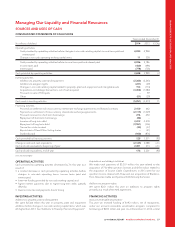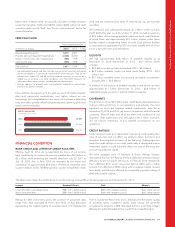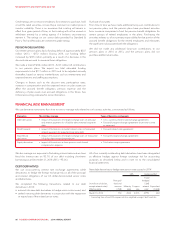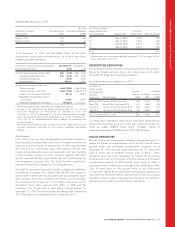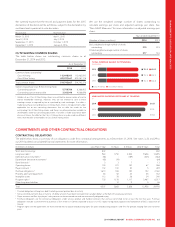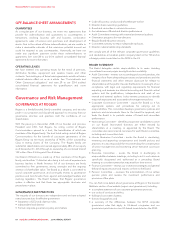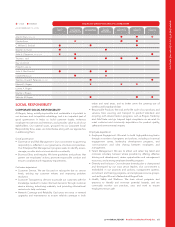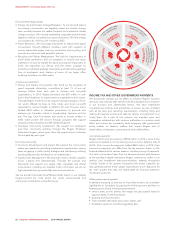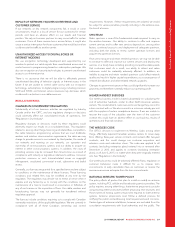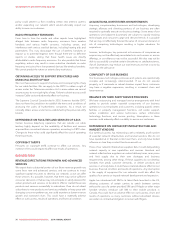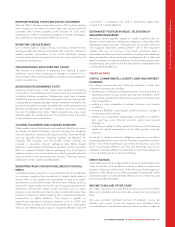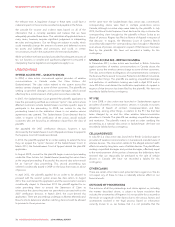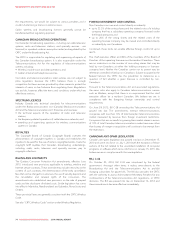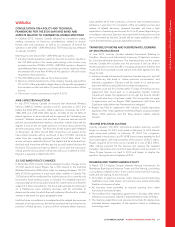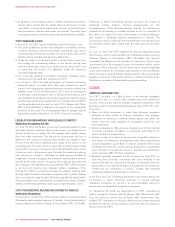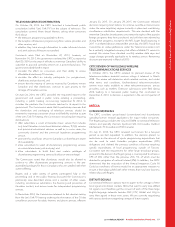Rogers 2014 Annual Report Download - page 71
Download and view the complete annual report
Please find page 71 of the 2014 Rogers annual report below. You can navigate through the pages in the report by either clicking on the pages listed below, or by using the keyword search tool below to find specific information within the annual report.
MANAGEMENT’S DISCUSSION AND ANALYSIS
As outlined in the table below, the total cost to Rogers of these payments in 2014 was approximately $1,140 million.
(In millions of dollars)
Income
taxes
Non-recoverable
sales taxes Payroll taxes
Regulatory and
spectrum fees 1
Property and
business taxes
Total taxes and
other payments
Total payments 460 8 132 496 44 1,140
1Includes an allocation of $264.5 million relating to the $1.0 billion and $3.3 billion we paid for the acquisition of spectrum licences in 2008 and 2014, respectively.
We also collected on behalf of the government approximately $1,667
million in sales taxes on our products and services and $545 million in
employee payroll taxes.
RISK MANAGEMENT
We are committed to continually strengthening our risk management
capabilities to protect and enhance shareholder value. The purpose of
risk management is not to eliminate risk but to optimize trade-offs
between risk and return to maximize value to the organization.
RISK GOVERNANCE
The Board has overall responsibility for risk governance and oversees
management in identifying the principal risks we face in our business
and implementing appropriate risk assessment processes to manage
these risks. It delegates certain risk oversight and management duties
to the Audit Committee.
The Audit Committee discusses risk policies with management and the
Board, and assists the Board in overseeing our compliance with legal
and regulatory requirements.
The Audit Committee also reviews:
• the adequacy of the internal controls that have been adopted to
safeguardassetsfromlossandunauthorized use, to prevent, deter
and detect fraud and to ensure the accuracy of the financial records;
• the processes for identifying, assessing and managing risks;
• our exposure to major risks and trends and management’s
implementation of risk policies and actions to monitor and control
these exposures;
• our business continuity and disaster recovery plans;
• any special audit steps adopted due to material weaknesses or
significant deficiencies that may be identified; and
• other risk management matters from time to time as determined by
the Audit Committee or directed by the Board.
ENTERPRISE RISK MANAGEMENT
Our Enterprise Risk Management program uses the “3 Lines of
Defence” framework to identify, assess, manage, monitor and
communicate risks. The Executive Leadership Team with its associated
business units and departments is the first line of defence. The
Executive Leadership Team with the business units and departments
identify and assess key risks and define controls and action plans to
minimize these risks to enhance our ability to meet our business
objectives. This group owns the risks. Management within the business
units and departments is responsible for maintaining effective controls
on a day-to-day basis to reduce risks to an acceptable level.
Enterprise Risk Management is the second line of defence. As part of
their role, Enterprise Risk Management supports the Executive
Leadership Team to identify the organization’s risk appetite, identify
emerging risks, and monitor the adequacy and effectiveness of the
controls to reduce risks to an acceptable level. At the business unit
level, Enterprise Risk Management works with the business to provide
governance and oversight in managing the key risks and associated
controls to mitigate these risks.
Enterprise Risk Management carries out an annual strategic risk
assessment to identify our principal risks and their potential impact on
our ability to achieve our business objectives. This assessment includes
reviewing risk reports, audit reports and industry benchmarks, and
interviewing key risk owners. Enterprise Risk Management reports the
results of the annual strategic risk assessment to the Executive
Leadership Team and the Audit Committee. Enterprise Risk
Management also conducts a formal management survey every two
years to get management feedback on the key risks facing the
organization and identify emerging risks. These risks are prioritized
using standard risk assessment criteria.
Internal Audit is the third line of defence. Internal Audit evaluates the
design and operational effectiveness of the governance program,
internal controls and Risk management. Risks, controls and mitigation
plans identified through this process are incorporated into the annual
Internal Audit plan. Annually, Internal Audit also facilitates and monitors
management’s completion of the financial fraud risk assessment to
identify areas of potential fraud in our financial statements and to
ensure these controls are designed and operating effectively.
The Executive Leadership Team and the Audit Committee are
responsible for approving our enterprise risk policies. Our Enterprise
Risk Management methodology and policies rely on the expertise of
our management and employees to identify risks and opportunities,
and implement risk mitigation strategies as required.
RISKS AND UNCERTAINTIES AFFECTING OUR
BUSINESS
This section describes the principal risks and uncertainties that could
have a material adverse effect on our business and financial results.
Any discussion about risks should be read in conjunction with “About
Forward-Looking Information”.
GENERAL RISKS
ECONOMIC CONDITIONS
Our businesses are affected by general economic conditions and
consumer confidence and spending. Recessions, declines in economic
activity and economic uncertainty can erode consumer and business
confidence and reduce discretionary spending. Any of these factors
can negatively affect us through reduced advertising, lower demand
for our products and services, decreased revenue and profitability, and
higher churn and bad debt expense. A significant portion of our
broadcasting, publishing and digital revenues come from the sale of
advertising.
2014 ANNUAL REPORT ROGERS COMMUNICATIONS INC. 67


